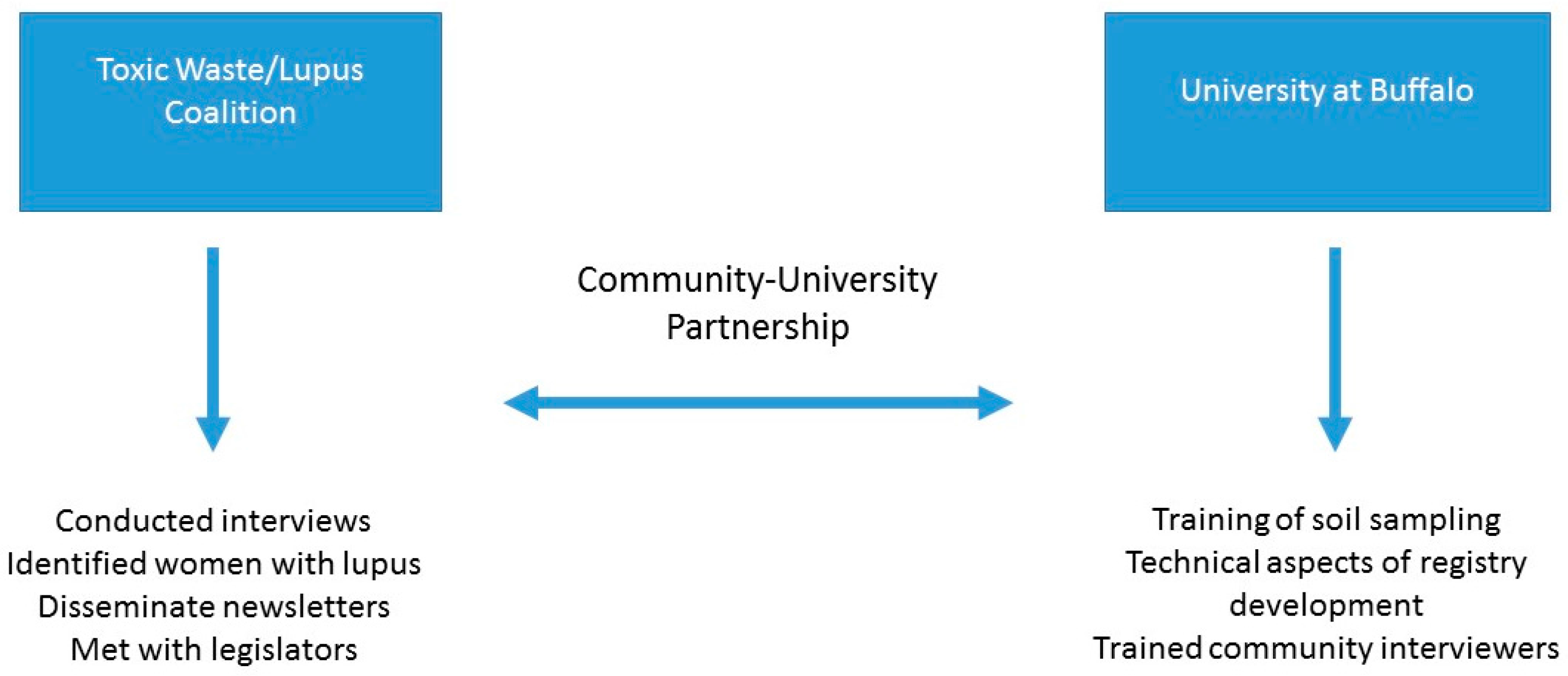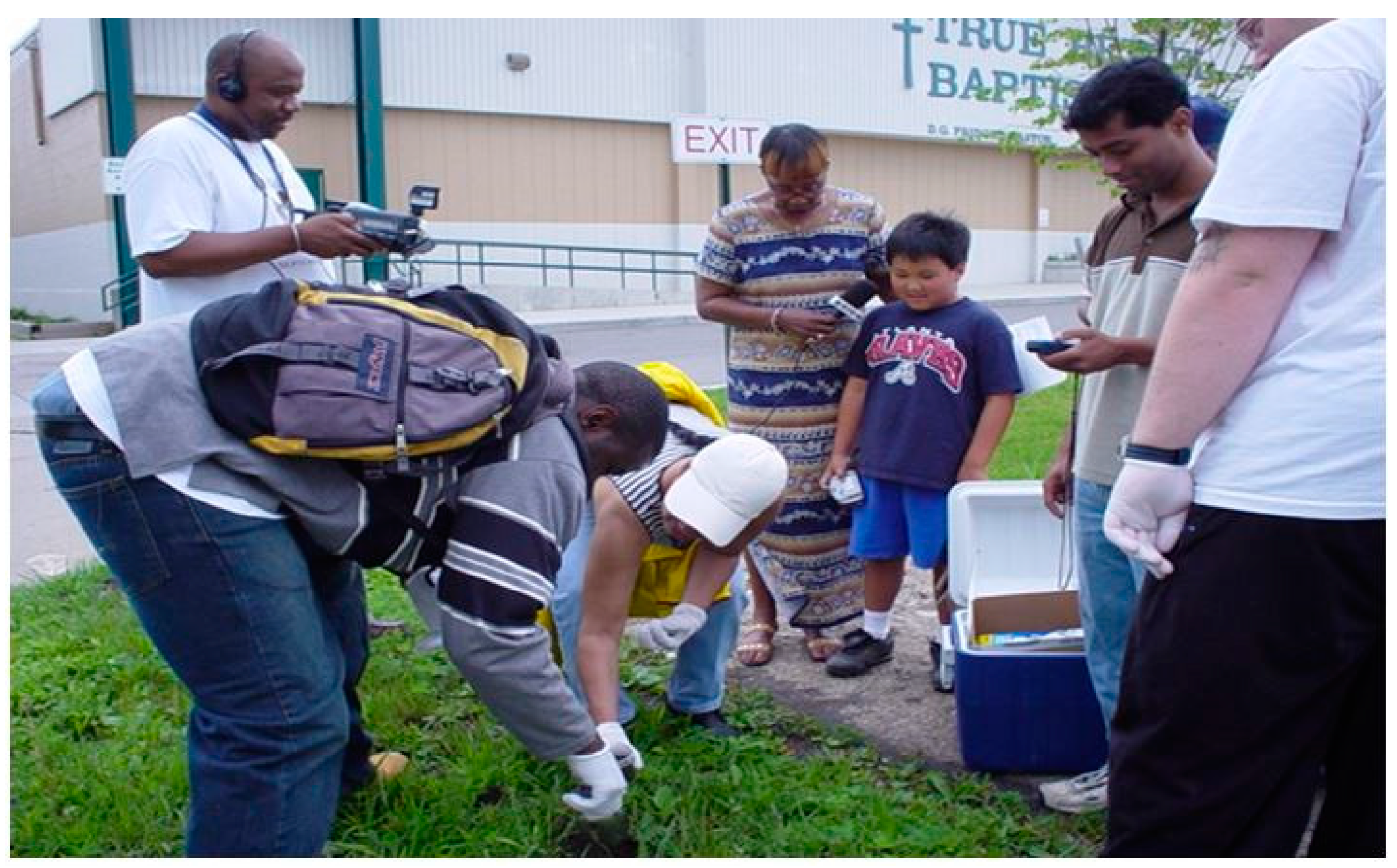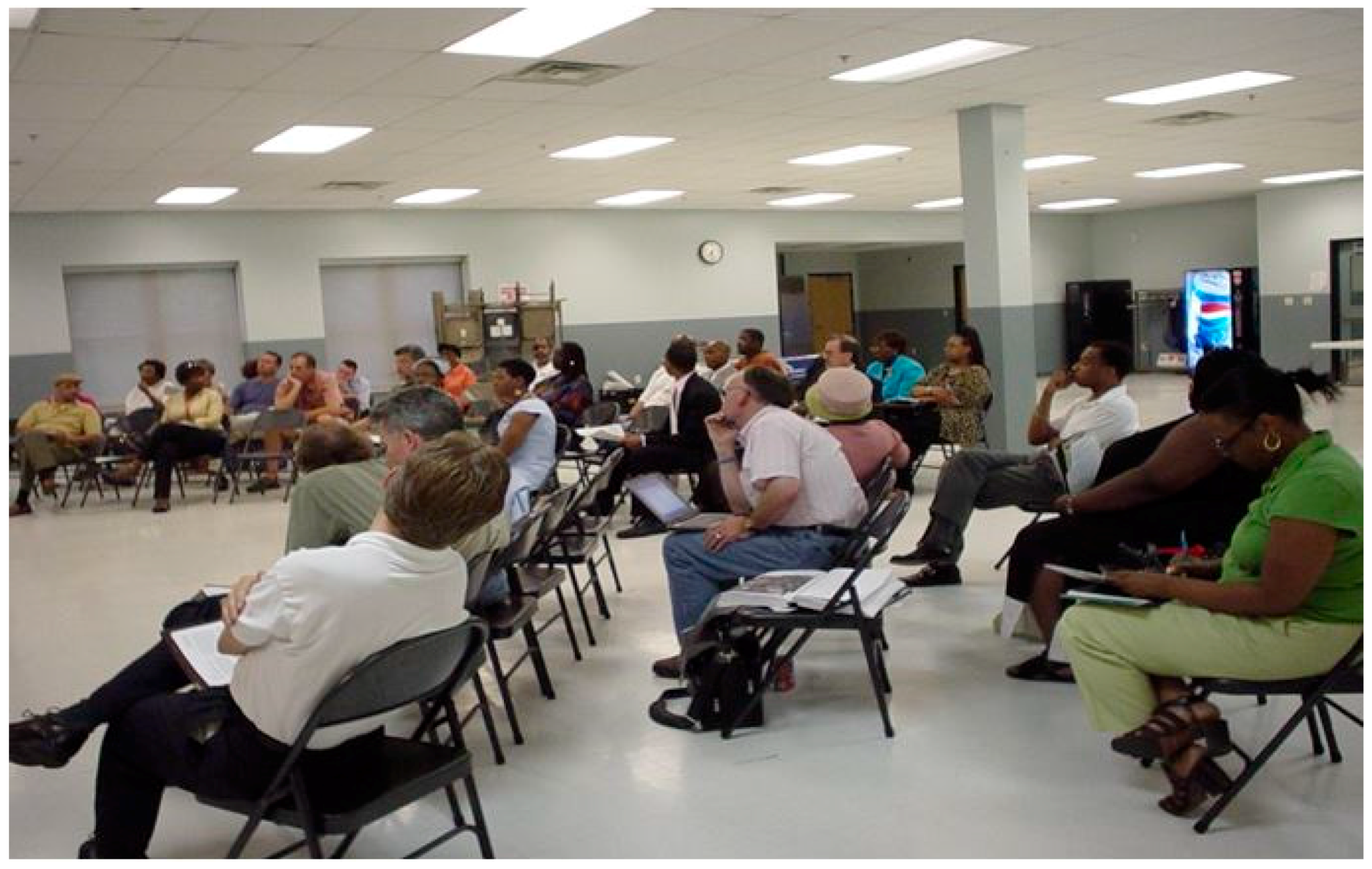A Case Study of Community Involvement Influence on Policy Decisions: Victories of a Community-Based Participatory Research Partnership
Abstract
:1. Introduction
Community-Based Participatory Research: A Historical Perspective
2. Experimental Section
Research Efforts
3. Results
3.1. Sampling Results
3.2. Capacity-Building
3.3. Continued Community Activism
4. Conclusions
Acknowledgments
Author Contributions
Conflicts of Interest
References
- United Church of Christ (UCC) Commission for Racial Justice. Toxic wastes and race in the United States: A National Report on the Racial and Socioeconomic Characteristics of Communities with Hazardous Waste Sites; Commission for Racial Justice: New York, NY, USA, 1987. [Google Scholar]
- Bullard, R.D.; Mohai, P.; Saha, R.; Wright, B. Toxic Wastes and Race at Twenty 1987–2007: Grassroots Struggles to Dismantle Environmental Racism in the United States; United Church of Christ: Cleveland, OH, USA, 2007. [Google Scholar]
- Bryant, B. Environmental Justice: Issues, Policies and Solutions; Island Press: Washington, DC, USA, 1995. [Google Scholar]
- Bryant, B.; Mohai, P. Race and the Incidence of Environmental Hazards: A Time for Discourse; Westview Press: Boulder, CO, USA, 1992. [Google Scholar]
- Bullard, R. Environmental Justice for all. In Unequal Protection: Environmental Justice & Communities of Color; Bullard, R., Ed.; Sierra Club Books: San Francisco, CA, USA, 1994. [Google Scholar]
- Bullard, R.D. Dumping in Dixie: Race, Class and Environmental Quality, 3rd ed.; Westview Press: Boulder, CO, USA, 2000. [Google Scholar]
- Bullard, R.D. Growing Smarter: Achieving Livable Communities, Environmental Justice, and Regional Equity; The MIT Press: Cambridge, MA, USA, 2007. [Google Scholar]
- Bullard, R.D. The Quest for Environmental Justice: Human Rights and the Politics of Pollution; The University of California Press: Berkeley, CA, USA, 2005. [Google Scholar]
- Payne-Sturges, D.; Gee, G.C. National environmental health measures for minority and low income populations: An approach for tracking environmental health disparities. Environ. Res. 2006, 102, 154–171. [Google Scholar] [CrossRef] [PubMed]
- Gee, G.; Payne-Sturges, D. Environmental health disparities: A framework integrating psychosocial and environmental concepts. Environ. Health Perspect. 2004, 112, 1645–1653. [Google Scholar] [CrossRef] [PubMed]
- Morello-Frosch, R.; Jesdale, B.M. Separate and unequal: Residential segregation and estimated cancer risks associated with ambient air toxics in U.S. metropolitan areas. Environ. Health Perspect. 2006, 114, 386–393. [Google Scholar] [CrossRef] [PubMed]
- Morello-Frosch, R.; Lopez, R. The riskscape and the color line: Examining the role of segregation in environmental health disparities. Environ. Res. 2006, 102, 181–196. [Google Scholar] [CrossRef] [PubMed]
- Morello-Frosch, R.; Pastor, M., Jr.; Porras, C.; Sadd, J. Environmental justice and southern California’s “riskscape”: The distribution of air toxics exposures and health risks among diverse communities. Urban Aff. Rev. 2001, 36, 551–578. [Google Scholar] [CrossRef]
- Evans, G.W.; Kantrowitz, E. Socioeconomic status and health: The potential role of environmental risk exposure. Ann. Rev. Public Health 2002, 23, 303–331. [Google Scholar] [CrossRef] [PubMed]
- Israel, B.A.; Eng, E.; Schulz, A.J.; Parker, E.A. Methods in Community-Based Participatory Research; Jossey-Bass: San Francisco, CA, USA, 2005. [Google Scholar]
- Israel, B.A.; Parker, E.A.; Rowe, Z.; Salvatore, A.; Minkler, M.; López, J.; Butz, A.; Mosley, A.; Coates, L.; Lambert, G.; et al. Community-based participatory research: Lessons learned from the Centers for Children’s Environmental Health and Disease Prevention Research. Environ. Health Perspect. 2005, 113, 1463–1471. [Google Scholar] [CrossRef] [PubMed]
- Israel, B.A.; Schulz, A.J.; Parker, E.A.; Becker, A.B. Review of community-based research: Assessing partnership approaches to improve public health. Annu. Rev. Public Health 1998, 19, 173–202. [Google Scholar] [CrossRef] [PubMed]
- Minkler, M. Community-based research partnerships: Challenges and opportunities. J. Urban Health 2005, 82 (Suppl. 2), 3–11. [Google Scholar] [CrossRef] [PubMed]
- Minkler, M. Ethical challenges for the “outside” researcher in community-based participatory research. Health Educ. Behav. 2004, 31, 684–701. [Google Scholar] [CrossRef] [PubMed]
- Minkler, M.; Wallerstein, N. Community-Based Participatory Research for Health; Jossey-Bass: San Francisco, CA, USA, 2003. [Google Scholar]
- Srinivasan, S.; Collman, G.W. Evolving partnerships in community. Environ. Health Perspect. 2005, 113, 1814–1816. [Google Scholar] [CrossRef] [PubMed]
- O’Fallon, L.R.; Dearry, A. Community-based participatory research as a tool to advance environmental health sciences. Environ. Health Perspect. 2002, 110 (Suppl. 2), 155–159. [Google Scholar] [CrossRef] [PubMed]
- O’Fallon, L.R.; Tyson, F.; Dearry, A. Improving public health through community-based participatory research and education. Environ. Epidemiol. Toxicol. 2000, 2, 201–209. [Google Scholar]
- Vasquez, V.B.; Minkler, M.; Shepard, P. Promoting environmental health policy through community based participatory research: A case study from Harlem, New York. J. Urban Health 2006, 83, 101–110. [Google Scholar] [PubMed]
- Wing, S. Social responsibility and research ethics in community-driven studies of industrialized hog production. Environ. Health Perspect. 2002, 110, 437–444. [Google Scholar] [CrossRef] [PubMed]
- Coburn, J. Street Science: Community Knowledge and Environmental Health Justice; The MIT Press: Cambridge, MA, USA, 2005. [Google Scholar]
- Coburn, J. Bringing local knowledge into environmental decision-making: Improving urban planning for communities at risk. J. Plan. Educ. Res. 2003, 22, 420–433. [Google Scholar] [CrossRef]
- West Harlem Environmental Action (WEACT). WEACT History. Available online: http://www.weact.org/downloads/index.html (accessed on 27 September 2007).
- Kinney, P.; Northridge, M.; Chew, G.L.; Gronning, E.; Joseph, E.; Correa, J.C.; Prakash, S.; Goldstein, I. On the front lines: An environmental asthma intervention in New York City. Am. J. Public Health 2002, 92, 24–26. [Google Scholar] [CrossRef] [PubMed]
- O’Rourke, D.; Macey, G.P. Community environmental policing: Assessing new strategies of public participation in environmental regulation. J. Policy Anal. Manag. 2003, 22, 383–414. [Google Scholar] [CrossRef]
- Lerner, S.; Diamond, A. A Struggle for Environmental Justice in Louisiana’s Chemical Corridor; The MIT Press: Cambridge, MA, USA, 2005. [Google Scholar]
- The Pacific Institute and the 7th St. Neighborhood Improvement Initiative. Neighborhood Knowledge for Change: The West Oakland Environmental Indicators Project; The Pacific Institute: Oakland, CA, USA, 2002. [Google Scholar]
- Wilson, S.M.; Wilson, O.R.; Heaney, C.D.; Cooper, J. Use of EPA collaborative problem-solving model to obtain environmental justice in North Carolina. Progr. Commun. Health Partnersh. Res. Educ. Action 2007, 1, 327–338. [Google Scholar] [CrossRef] [PubMed]
- Heaney, C.D.; Wilson, S.M.; Wilson, O.R. Community-owned and managed research (COMR): A new approach to community-driven environmental justice research. Progr. Commun. Health Partnersh. Res. Educ. Action. 2007, 1, 339–349. [Google Scholar] [CrossRef] [PubMed]
- Wilson, S.M.; Wilson, O.R.; Heaney, C.D.; Cooper, J. Community Driven Environmental Protection: Reducing the P.A.I.N. of the Built Environment in Low-Income African-American Communities in North Carolina. Soc. Justice Context 2008, 3, 41–58. [Google Scholar]
- West End Revitalization Association (WERA). EPA Environmental Justice Study: Failing Septic Systems and Contaminated well Waters: African-American Communities in Mebane, North Carolina; EPA: Washington, DC, USA, 2002. [Google Scholar]
- Wing, S.; Grant, G.; Green, M.; Stewart, C. Community based collaboration for environmental justice: Southeast Halifax environmental reawakening. Environ. Urban 1996, 8, 129–140. [Google Scholar] [CrossRef]
- Baron, S.; Sinclair, R.; Payne-Sturges, D.; Phelps, J.; Zenick, H.; Collman, G.W.; O’Fallon, L.R. Partnerships for environmental and occupational justice: Contributions to research, capacity and public health. Am. J. Publ. Health 2009, 99, S517–S525. [Google Scholar] [CrossRef] [PubMed]
- O’Brien, B.C.; Harris, I.B.; Beckman, T.J.; Reed, D.A.; Cook, D.A. Standards for Reporting Qualitative Research: A Synthesis of Recommendations. Acad. Med. 2014, 89, 1245–1251. [Google Scholar] [CrossRef] [PubMed]
- Bruce, S.A.; Austin-Ketch, T. Community-based participatory research: An exemplar of learning. Am. J. Nurse Pract. 2006, 10, 24–33. [Google Scholar]
- Gardella, J.A., Jr.; Milillo, T.M.; Sinha, G.; Oh, G.; Manns, D.C.; Coffey, E. Linking community service, learning, and environmental analytical chemistry. Anal. Chem. 2007, 810–818. [Google Scholar] [CrossRef]
- New York State Department of Health. Promoting Lead-free Children in New York State: A Report of Lead Exposure Status among New York Children; New York State Department of Health: New York, NY, USA, 2003. [Google Scholar]
- New York State Department of Health. Health Department Report Shows Dramatic Decline in New York State Childhood Lead Poisoning Cases: State Media Campaign to Target High Lead Level Areas to Help Build on Progress Made over the Past Four Years; New York State Department of Health: New York, NY, USA, 2001. [Google Scholar]



| Remediation Option | Cost | Action |
|---|---|---|
| $0 | Remain hazardous with no use |
| $35 million | industrial use |
| $1.6 million | Cap waste on site with some beneficial use |
| $50 million | Unrestricted use on and off site |
| $16 million | On site with cap for industrial use and some beneficial use |
© 2016 by the authors; licensee MDPI, Basel, Switzerland. This article is an open access article distributed under the terms and conditions of the Creative Commons Attribution (CC-BY) license (http://creativecommons.org/licenses/by/4.0/).
Share and Cite
Williams, E.M.; Terrell, J.; Anderson, J.; Tumiel-Berhalter, L. A Case Study of Community Involvement Influence on Policy Decisions: Victories of a Community-Based Participatory Research Partnership. Int. J. Environ. Res. Public Health 2016, 13, 515. https://doi.org/10.3390/ijerph13050515
Williams EM, Terrell J, Anderson J, Tumiel-Berhalter L. A Case Study of Community Involvement Influence on Policy Decisions: Victories of a Community-Based Participatory Research Partnership. International Journal of Environmental Research and Public Health. 2016; 13(5):515. https://doi.org/10.3390/ijerph13050515
Chicago/Turabian StyleWilliams, Edith M., Julien Terrell, Judith Anderson, and Laurene Tumiel-Berhalter. 2016. "A Case Study of Community Involvement Influence on Policy Decisions: Victories of a Community-Based Participatory Research Partnership" International Journal of Environmental Research and Public Health 13, no. 5: 515. https://doi.org/10.3390/ijerph13050515
APA StyleWilliams, E. M., Terrell, J., Anderson, J., & Tumiel-Berhalter, L. (2016). A Case Study of Community Involvement Influence on Policy Decisions: Victories of a Community-Based Participatory Research Partnership. International Journal of Environmental Research and Public Health, 13(5), 515. https://doi.org/10.3390/ijerph13050515





